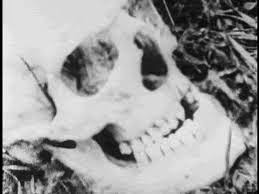Oddball Films Media
•
Jul 18, 2015
Oddball Films presents The Makings of Genius, featuring rare 16mm shorts films made early in the careers of such visionary filmmakers as Ken Russell, Roman Polanski, Orson Welles, Istvan Szabo, Jim Hens*n and Steven Spiel∂erg. The audacious Ken Russell (Tommy, Altered States) shows us his softer side with one of his very first short films, Amelia and the Angel (1957) about a little girl's quest for redemption through the streets of Post-War London.
Oscar winning Hungarian director Istvan Szabo's You... (1963) is a new wave love letter to a beautiful girl and the city of Budapest.
Amelia and the Angel (B+W, 1957, Ken Russell)
An utterly charming early short from one of Britain's most iconoclastic directors, the late great Ken Russell (Tommy, Altered States, The Devils). The almost too adorable Amelia (played by Argentinian moppet Mercedes Quadros) is getting ready for her stage debut as an angel with her dance class. Against the teacher's advice, she borrows her wings to take home to show her mother. But as her brother is a "horrible little beast", he absconds with the wings and destroys them summarily. Amelia must run all over the city to find a new pair of wings before her performance. She runs into obstacles and colorful characters aplenty (including an equally adorable circus dog) in her quest to redeem herself. While markedly more tame than Russell's work from the 70s and 80s, it is clearly his own with echoes of the themes of the absurdities of faith and a theatricality that would persist through most of his work. Ethereal, entertaining and inspiring, it's a rare treat from a Master.
Two Men and a Wardrobe (B+W, 1958, Roman Polanski)
Roman Polanski’s darkly comic early film has many of the director’s preoccupations already present: alienation, crisis in identity, and a bizarre view of humanity that sees us as some very strange animals. In this quasi-surrealist jaunt, two otherwise normal looking men emerge from the sea carrying an enormous wardrobe, which they proceed to carry around a nearby town. Seeking fun, solace, or maybe some place to put the damn thing, all the two find is rejection at every turn. Watch for Polanski in a bit part he later reprises in Chinatown. “Two Men and a Wardrobe” initiated Polanski’s collaboration with Krzysztof Komeda, the great Polish jazz composer who went on to score such Polanski hallmarks as Knife in the Water, Cul de Sac, and Rosemary's Baby.
Amblin' (Color, 1968, Steven Spielßerg)The man that redefined "blockbuster" got his start with this laid back, rambling hippie road movie. A young man (Richard Levin) hits the pavement with his guitar case and hitching thumb, looking to wander across America. He meets Pamela McMyler also hitching down the road in the desert. The two decide to head out together, engaging in olive spitting contests, joint smoking in caves and love-making in sleeping bags. But will this summer romance continue on when the girl learns he isn't everything she thought he was? Sweet and humorous, this is not only a fascinating curio from a huge director, but a great snapshot of the times and carefree feeling of youth in the late 1960s.
 You . . . (B+W, 1963, Istvan Szabo)A breezy take on the New Wave sensibility. As this stylish short attempts to capture the energy of our youthful heroine’s busy urban revels it also becomes a study of Budapest, seemingly this young woman’s plaything. Cecília Esztergályos co-stars with Hungary’s capital city. One of his early short works, Szabo later went on to win an Oscar for Mephisto in 1981 and continues to be one of the most influential directors in Hungarian cinema.
You . . . (B+W, 1963, Istvan Szabo)A breezy take on the New Wave sensibility. As this stylish short attempts to capture the energy of our youthful heroine’s busy urban revels it also becomes a study of Budapest, seemingly this young woman’s plaything. Cecília Esztergályos co-stars with Hungary’s capital city. One of his early short works, Szabo later went on to win an Oscar for Mephisto in 1981 and continues to be one of the most influential directors in Hungarian cinema.
Time Piece (Color, 1965, Jim Hens@n)
This Oscar-nominated live-action short from M*ppets creator Jim H*nson is a rare treat, perhaps just for adults. Starring the young H*nson himself, a hospitalized man is sent through the ringer in this absurd commentary on modernity lost to the harried city around him, money, sex, food, industry, and most of all, time. Drawing on his prowess as puppeteer, H*nson crafts this surreal, racy, quick-cutting gem. The percussion is by swing and bop drummer Ed Shaughnessy (who also appears) and was recorded by the legendary Blue Note Records engineer Rudy Van Gelder.
The Hearts of Age (B+W, 1934, Orson Welles)
Back in the summer of 1934 Orson Welles, only 19 years old, joined up with William Vance, a high school friend, and shot The Hearts of Age. It ran eight short minutes and featured four cast members: Welles, Vance, Virginia Nicholson (Welles’ girlfriend and eventual first wife) and Paul Edgerton. Meanwhile, the plot was surreal, cryptic, hard to follow — all for a good reason. The film's action, such as it is, is intercut with random shots of bells, headstones, a church cross and other images, some times printed in negative.
In an interview with Peter Bogdanovich, Welles claimed that The Hearts of Age was nothing but a parody of Jean Cocteau’s first film, The Blood of a Poet (1930). It was also a “joke,” a film “shot in two hours, for fun, one Sunday afternoon. It has no sort of meaning.” Some d critics disagree and claim the film lays the foundation for Welles brilliant future work.

 You . . . (B+W, 1963, Istvan Szabo)
You . . . (B+W, 1963, Istvan Szabo)




